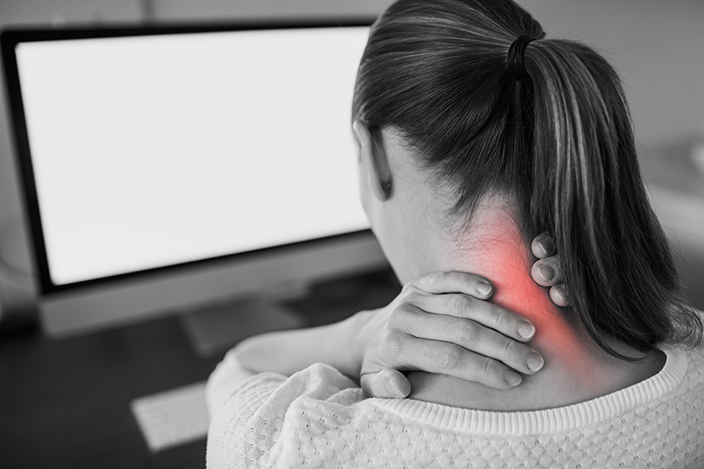Body mass, age and even time of day can influence neck pain, study says

Ah, that all-too-familiar ache at the back of the neck. With roughly 80 percent of jobs being sedentary and often requiring several hours of sitting stooped in front of a computer screen, neck pain is a growing occupational hazard. Smartphones and other devices have also caused people to bend their necks for prolonged periods. But is bad posture solely to blame?
In a recent study, researchers at Texas A&M University have found that while poor neck and head postures are indeed the primary determinants of neck pain, body mass index, age and the time of the day also influence the neck’s ability to perform sustained or repeated movements.
“Neck pain is one of the leading and fastest-growing causes of disability in the world,” said Xudong Zhang, professor in the Wm Michael Barnes ’64 Department of Industrial and Systems Engineering. “Our study has pointed to a combination of work and personal factors that strongly influence the strength and endurance of the neck over time. More importantly, since these factors have been identified, they can then be modified so that the neck is in better health and pain is avoided or deterred.”
The results of the study are published online in the journal Human Factors, a flagship journal in the field of human factors and ergonomics.
According to the Global Burden of Disease Study by the Institute for Health Metrics and Evaluation, neck pain is ranked as the fourth leading cause of global disability. One of the main reasons for neck pain has been attributed to lifestyle, particularly when people spend long durations of time with their necks bent forward. However, Zhang said a systematic, quantitative study has been lacking on how personal factors, such as sex, weight, age and work-related habits, can affect neck strength and endurance.
For their experiments, Zhang and his team recruited 20 adult men and 20 adult women with no previous neck-related issues to perform controlled head-neck exertions in a laboratory setting. Further, instead of asking the participants to hold a specific neck posture for a long time, similar to what might happen at a workplace, they performed “sustained-till exhaustion” head-neck exertions.
“In the laboratory, conducting experiments where subjects do long tasks with their neck can take several hours of data collection, which is not very practical for the experimenters and, of course, the participants in our study,” said Zhang. “To solve this problem, our experiments were strategically designed to mimic workplace neck strains but in a shorter period of time.”
In these exercises, subjects were seated and asked to put on an augmented helmet that allowed them to exert measurable force by the neck. Then, the researchers asked them to either keep their necks straight or maintain their neck tilted in a forward or backward position. In this position, a force was applied to their head and neck on an adjustable frame. This exertion was either to their maximum capacity or half of it. Before testing, the researchers noted their subjects’ age, body mass index and the time of day.
When Zhang and his team analyzed their data, they found that, as expected, work-related factors like head/neck posture play a very important role in determining both neck strength and endurance. But they also observed that while there was no significant difference between male and female subjects in neck endurance, body mass index was a significant predictor of neck endurance. Also, to their surprise, the time of day affected the neck’s ability to sustain an exertion without fatigue.
This research is funded by the National Institute for Occupational Safety and Health, part of the Centers for Disease Control and Prevention.

